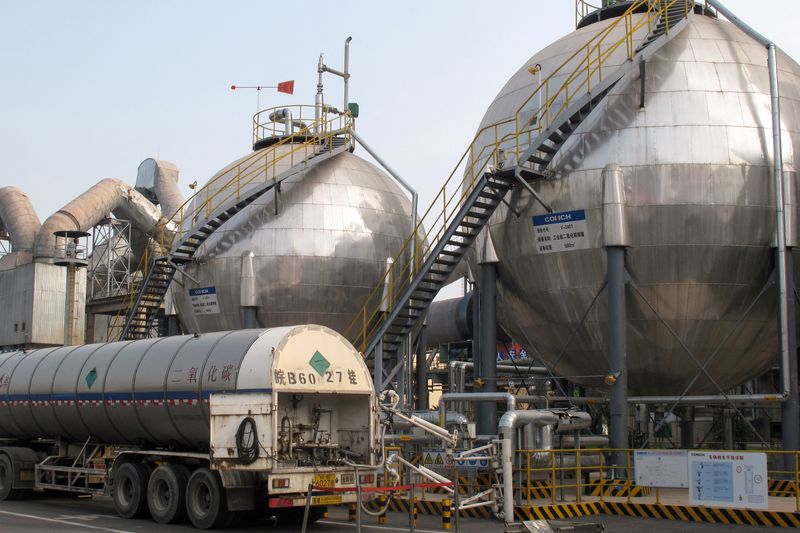BCA warns Fed consensus at risk as Hassett era looms
By Leah Douglas
(Reuters) -Technologies that capture carbon dioxide emissions to keep them from the atmosphere are central to the climate strategies of many world governments as they seek to follow through on international commitments to decarbonize by mid-century.
They are also expensive, unproven at scale, and can be hard to sell to a nervous public - making unworkable, at the moment, the model envisaged worldwide of capturing carbon and storing it for money.
As nations gather for the 28th United Nations climate change conference in the United Arab Emirates at the end of November, the question of carbon capture’s future role in a climate-friendly world will be in focus. Here are some details about the state of the industry now, and the obstacles in the way of widespread deployment:
FORMS OF CARBON CAPTURE
The most common form of carbon capture technology involves capturing the gas from a point source like an industrial smokestack. From there, the carbon can either be moved directly to permanent underground storage or it can be used in another industrial purpose first, variations that are respectively called carbon capture and storage (CCS) and carbon capture, utilization, and storage (CCUS).
There are currently 42 operational commercial CCS and CCUS projects across the world with the capacity to store 49 million metric tons of carbon dioxide annually, according to the Global CCS Institute, which tracks the industry. That is about 0.13% of the world’s roughly 37 billion metric tons of annual energy and industry-related carbon dioxide emissions.
Some 30 of those projects, accounting for 78% of all captured carbon from the group, use the carbon for enhanced oil recovery (EOR), in which carbon is injected into oil wells to free trapped oil. Drillers say EOR can make petroleum more climate-friendly, but environmentalists say the practice is counter-productive.
The other 12 projects, which permanently store carbon in underground formations without using them to boost oil output, are in the U.S., Norway, Iceland, China, Canada, Qatar, and Australia, according to the Global CCS Institute.
It is unclear how many of these projects, if any, turn a profit.
Another form of carbon capture is direct air capture (DAC), in which carbon emissions are captured from the air.
About 130 DAC facilities are being planned around the world, according to the International Energy Agency (IEA), though just 27 have been commissioned and they capture just 10,000 metric tons of carbon dioxide annually.
The U.S. in August announced $1.2 billion in grants for two DAC hubs in Texas and Louisiana that promise to capture 2 million metric tons of carbon per year, though a final investment decision on the projects has not been made.
HIGH COSTS
One stumbling block to rapid deployment of carbon capture technology is cost.
CCS costs range from $15 to $120 per metric ton of captured carbon depending on the emissions source, and DAC projects are even more expensive, between $600 and $1,000 per metric ton, because of the amount of energy needed to capture carbon from the atmosphere, according to the IEA.
Some CCS projects in countries like Norway and Canada have been paused for financial reasons.
Developers say they need a carbon price, either in the form of a carbon tax, trading scheme or tax break, that makes it profitable to capture and store the carbon. Without that, only carbon capture projects that increase revenue in a different way - like through increased oil output - are profitable.
Countries including the U.S. have rolled out public subsidies for carbon capture projects. The Inflation Reduction Act, passed in 2022, offers a $50 tax credit per metric ton of carbon captured for CCUS and $85 per metric ton captured for CCS, and $180 per metric ton captured through DAC.
Though those are meaningful incentives, companies may still need to take on some added costs to move CCS and DAC projects ahead, said Benjamin Longstreth, global director of carbon capture at the Clean Air Task Force.
Some CCS projects have also failed to prove out the technology's readiness. A $1 billion project to harness carbon dioxide emissions from a Texas coal plant, for example, had chronic mechanical problems and routinely missed its targets before it was shut down in 2020, according to a report submitted by the project’s owners to the U.S. Department of Energy.
The Petra Nova project restarted in September.
LOCATION, LOCATION, LOCATION
Where captured carbon can be stored is limited by geology, a reality that would become more pronounced if and when carbon capture is deployed at the kind of massive scale that would be needed to make a difference to the climate. The best storage sites for carbon are in portions of North America, East Africa, and the North Sea, according to the Global CCS Institute.
That means getting captured carbon to storage sites could require extensive pipeline networks or even shipping fleets – posing potential new obstacles.
In October, for example, a $3 billion CCS pipeline project proposed by Navigator CO2 Ventures in the U.S. Midwest - meant to move carbon from heartland ethanol plants to good storage sites - was canceled amid concerns from residents about potential leaks and construction damage.
Companies investing in carbon removal need to take seriously community concerns about new infrastructure projects, said Simone Stewart, industrial policy specialist at the National Wildlife Federation.
"Not all technologies are going to be possible in all locations," Stewart said.
